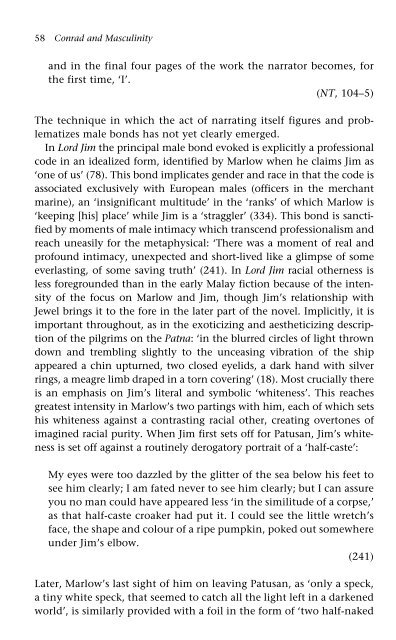Conrad and Masculinity
Conrad and Masculinity
Conrad and Masculinity
You also want an ePaper? Increase the reach of your titles
YUMPU automatically turns print PDFs into web optimized ePapers that Google loves.
58 <strong>Conrad</strong> <strong>and</strong> <strong>Masculinity</strong><br />
<strong>and</strong> in the final four pages of the work the narrator becomes, for<br />
the first time, ‘I’.<br />
(NT, 104–5)<br />
The technique in which the act of narrating itself figures <strong>and</strong> problematizes<br />
male bonds has not yet clearly emerged.<br />
In Lord Jim the principal male bond evoked is explicitly a professional<br />
code in an idealized form, identified by Marlow when he claims Jim as<br />
‘one of us’ (78). This bond implicates gender <strong>and</strong> race in that the code is<br />
associated exclusively with European males (officers in the merchant<br />
marine), an ‘insignificant multitude’ in the ‘ranks’ of which Marlow is<br />
‘keeping [his] place’ while Jim is a ‘straggler’ (334). This bond is sanctified<br />
by moments of male intimacy which transcend professionalism <strong>and</strong><br />
reach uneasily for the metaphysical: ‘There was a moment of real <strong>and</strong><br />
profound intimacy, unexpected <strong>and</strong> short-lived like a glimpse of some<br />
everlasting, of some saving truth’ (241). In Lord Jim racial otherness is<br />
less foregrounded than in the early Malay fiction because of the intensity<br />
of the focus on Marlow <strong>and</strong> Jim, though Jim’s relationship with<br />
Jewel brings it to the fore in the later part of the novel. Implicitly, it is<br />
important throughout, as in the exoticizing <strong>and</strong> aestheticizing description<br />
of the pilgrims on the Patna: ‘in the blurred circles of light thrown<br />
down <strong>and</strong> trembling slightly to the unceasing vibration of the ship<br />
appeared a chin upturned, two closed eyelids, a dark h<strong>and</strong> with silver<br />
rings, a meagre limb draped in a torn covering’ (18). Most crucially there<br />
is an emphasis on Jim’s literal <strong>and</strong> symbolic ‘whiteness’. This reaches<br />
greatest intensity in Marlow’s two partings with him, each of which sets<br />
his whiteness against a contrasting racial other, creating overtones of<br />
imagined racial purity. When Jim first sets off for Patusan, Jim’s whiteness<br />
is set off against a routinely derogatory portrait of a ‘half-caste’:<br />
My eyes were too dazzled by the glitter of the sea below his feet to<br />
see him clearly; I am fated never to see him clearly; but I can assure<br />
you no man could have appeared less ‘in the similitude of a corpse,’<br />
as that half-caste croaker had put it. I could see the little wretch’s<br />
face, the shape <strong>and</strong> colour of a ripe pumpkin, poked out somewhere<br />
under Jim’s elbow.<br />
(241)<br />
Later, Marlow’s last sight of him on leaving Patusan, as ‘only a speck,<br />
a tiny white speck, that seemed to catch all the light left in a darkened<br />
world’, is similarly provided with a foil in the form of ‘two half-naked




